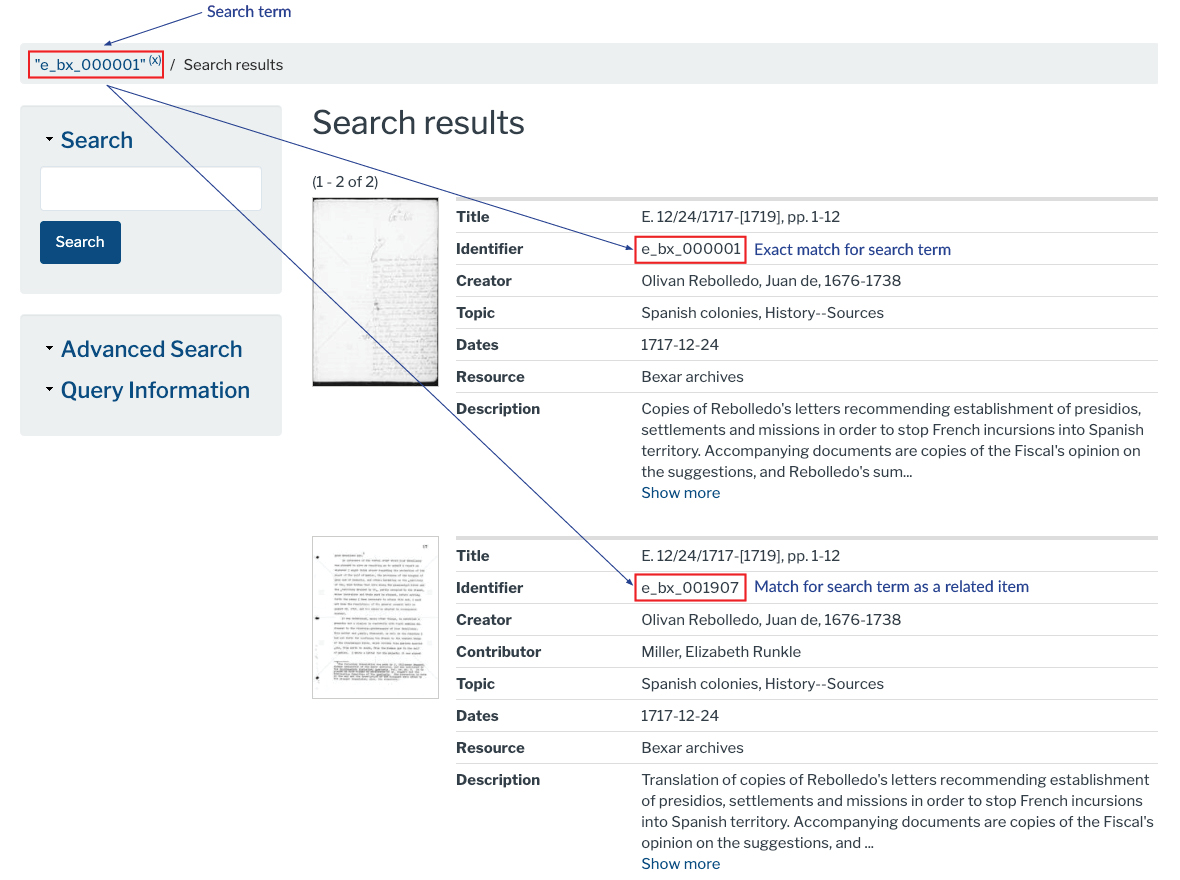Generations of Stewardship
After receiving the collection in 1899, librarians and historians at the University of Texas at Austin arranged all the documents—whether provincial, municipal, military, or private—into chronological order in the following series:
- Coahuila y Texas Official Publications, 1826–1835
- General Governmental Publications, 1730–1836
- Non-governmental Publications, 1778, 1811–1836
- Undated and Undated Fragments
- General Manuscript Series, 1717–1836
The Briscoe Center relies upon this arrangement to build tools for researchers to access items. The efforts of generations of stewards has propelled access to the Bexar Archives into the current millennium. Over the last century, information professionals built upon the works of their peers, first developing a card-based calendar introduced in 1932, then a second revised calendar between 1967 and 1971 as a companion to the microfilm edition of the Bexar Archives. The second calendar is comprised of thirty-seven typescript volumes available in the reading room of the Briscoe Center. Ranges of the calendar are available at the beginning of every roll in the microfilm edition of the Bexar Archives for user reference. Additionally, three guides to the microfilm edition containing a synopsis of content covered by roll were published. The calendar is available in PDF format from the Calendar link in the project page navigation bar.
For those interested in using the Bexar Archives for genealogical research, the center maintains a collection guide of census materials based on the microfilm edition. External scholarship such as the 1989 publication of The Bexar Archives (1717–1836): A Name Guide by Adán Benavides Jr. provides users of the Bexar Archives a means to search across microfilm rolls based on the names of people and places. A derivative work based upon Benavides’s A Name Guide, Mujeres: Women in the Bexar Archives: 1735–1836, was provided to the Briscoe Center in 2015 by David McDonald, Teresa Garza, Julianna Hutchinson, and Jeannie Navarro. This compilation highlights the documents in the Bexar Archives featuring women.
The long-standing translation program for the Bexar Archives is also based on the chronological arrangement of the documents. It does leverage some information from the second calendar, like document title and dates, but also contains descriptive information that can only be derived by a careful viewing of each individual item. The translation volumes contain indices based on the intimate review of documents by a translator. A compilation of these indices, the Bexar Archives Name Index, is made available by the Briscoe Center as a collection guide.
The “Search” and “Advanced Search” operate independently from one another and cannot be used in tandem. You can apply “Search Filters” on results from either type of search.

1. Simple Search
The “Search“ block provides a simple full-text search of all items in the repository. Searches can be refined by wrapping your terms in quotation marks. For example, searching for Bexar Archives will produce results that include every metadata record that contains the words Bexar or Archives. If you wrap these terms in quotes, like this “Bexar Archives,” your search results will only include records that contain both Bexar and Archives in that specific order.
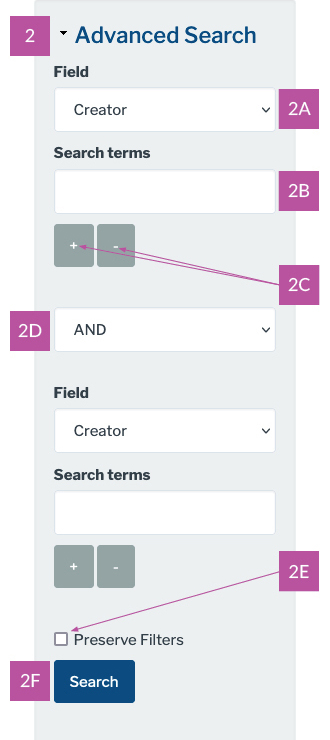
2. Advanced Search
The “Advanced Search“ block, seen in expanded form, provides a configurable search for users where specific metadata fields can be searched. Searches can be refined by wrapping your terms in quotation marks. Searches can be expanded by adding additional search terms from various fields combined with boolean operators (AND, OR, and NOT).
You may continue to refined your search results by adding or removing terms and filters. To maintain continuity between advanced searches be sure to select the “Preserve Filters“ option (2E) to save any applied Search Facets.
2A Field selection dropdown menu provides metadata field options available for use in an advanced search.
2B Text area for typing search terms. Wrapping your search terms in quotations will likely provide you better results.
2C The plus and minus buttons are used to add (plus) or remove (minus) conditions a user applies to their advanced search.
2D Boolean operator dropdown menu provides a user the option of how to combine their advanced search elements using AND, OR, and NOT. Learn more about using boolean operators using this guide from MIT Libraries.
2E Check this box to Preserve Filters. This should be selected when adding or removing search conditions after you have received initial results, applied Search Facets, and are continuing to add/remove additional search conditions to refine your results.
2F Search button used to submit your advanced search query.
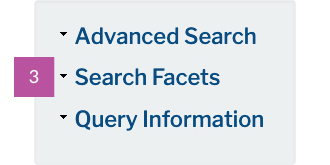
3. Search Facets
The “Search Facets“ located under the “Advanced Search“ provide a user the ability to refine search results by using relevant categories as filters.
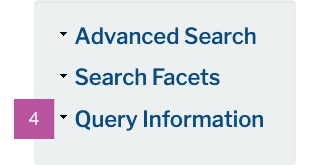
4. Query Information
The “Query Information“ option located under the “Search Facets“ shows a user the structure of their current query and any filters that are applied to the query.
The advent of high-quality digitization, faster internet connection speeds, and image display technologies made the first iteration of the Bexar Archives Online possible in the 2010s. Rolls from the microfilm edition were digitized as were the typescript pages from the calendar. The Briscoe Center's project team used optical character recognition software to make text editable files from the typescript calendar images. The team was then able to structure descriptive metadata records for individual documents found on a roll. In addition, the team set about the task of relating original documents to available English translations. These relationships were previously obfuscated by the divergence in source mediums (calendar based on microfilm and translations based on printed volumes).
The Bexar Archives Online modeled the existing descriptive information from the calendar into the Dublin Core metadata standard. In our latest release we have updated all Bexar Archives metadata to the Metadata Object Description Schema (MODS). As part of this process, all of the existing project metadata was reviewed and normalized, including the adoption of controlled vocabulary terms and the use of name authorities like FAST and VIAF. This repository utilizes the various fields within a MODS metadata records to facilitate additional connections and discovery and makes it possible to broaden or narrow search results through our Advanced Search or by applying Search Facets.
Sample MODS XML record
<mods xsi:schemaLocation="http://www.loc.gov/mods/v3 http://www.loc.gov/standards/mods/v3/mods-3-7.xsd"><identifier type="dbcah_local">e_bx_000001</identifier><titleInfo><title type="main" supplied="yes">E. 12/24/1717-[1719], pp. 1-12</title></titleInfo><name displayLabel="creator" type="personal"><namePart authority="viaf" valueURI="http://viaf.org/viaf/41003122">Olivan Rebolledo, Juan de, 1676-1738</namePart><role><roleTerm authority="marcrelator" valueURI="http://id.loc.gov/vocabulary/relators/cre">Creator</roleTerm></role></name><subject><geographic authority="local_historical_placenames" valueURI="camh_voc_028738">New Spain</geographic></subject><subject><topic authority="fast" valueURI="http://id.worldcat.org/fast/1930866">Spanish colonies</topic></subject><subject><topic authority="fast" valueURI="http://id.worldcat.org/fast/958295">History--Sources</topic></subject><abstract>Copies of Rebolledo's letters recommending establishment of presidios, settlements and missions in order to stop French incursions into Spanish territory. Accompanying documents are copies of the Fiscal's opinion on the suggestions, and Rebolledo's summary of Domingo Ramón's letter and plans for checking French incursions into Texas.</abstract><language><languageTerm type="code" authority="iso639-2b">spa</languageTerm></language><physicalDescription><extent unit="">13 frames</extent><digitalOrigin>digitized microfilm</digitalOrigin><reformattingQuality>access</reformattingQuality></physicalDescription><typeOfResource>text</typeOfResource><genre authority="aat" valueURI="http://vocab.getty.edu/aat/300026879">Letters (correspondence)</genre><relatedItem type="">e_bx_001907</relatedItem><originInfo><dateCreated encoding="w3cdtf" qualifier="">1717-12-24</dateCreated></originInfo><location><physicalLocation>The University of Texas at Austin</physicalLocation><holdingSimple><copyInformation><subLocation>Dolph Briscoe Center for American History</subLocation></copyInformation></holdingSimple></location><note type="resource">Bexar archives</note><note displayLabel="location_info" type="box">2S25</note><note displayLabel="location_info" type="roll">8</note><note displayLabel="location_info" type="frame">1-13</note><note type="collection_strength">Texas History</note><note type="project">Bexar archives online</note><note type="processing_note_2" displayLabel="display">For some records in this collection, variant forms of the same name may be presented as the creator. Alternate forms of names may exist in the Adán Benavides Bexar Archives Name Guide.</note></mods>
Display of MODS XML values online
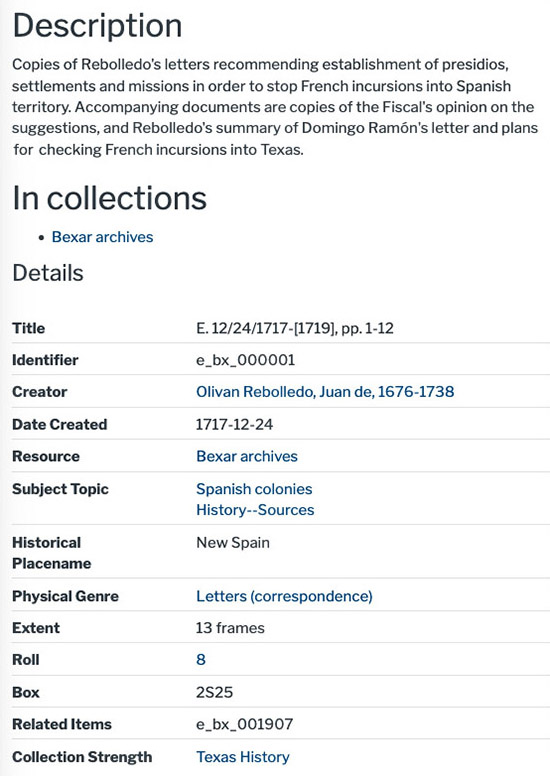
Analog access to materials in the Bexar Archives follows two parallel paths, each relying upon the chronological arrangement of documents. A patron would use the calendar to locate materials on microfilm or use the collection guide to request viewing originals in our reading room. Translations produced since 1935 are available in bound volumes, follow the chronological arrangement of the collection, and have a separate collection guide. Analog research would require a patron to cross reference the calendar and collection guides to locate both the original and a translation for any given document between 1717 and 1802.
The Bexar Archives Online is the first access tool to directly relate originals/microfilm surrogates to their corresponding translations. This is achieved in part by assigning all digitized items unique identifiers. Then, using the available analog research tools, the Bexar Archives project team solidified relationships between the digitized manuscript material and digitized translations. In the image below is the metadata for both the digitized microfilm and translation of the document titled “E. 12/24/1717-[1719], pp. 1-12.” The digitized microfilm for “E. 12/24/1717-[1719], pp. 1-12“ (image left) received the unique identifier e_bx_000001. While the translation for “E. 12/24/1717-[1719], pp. 1-12“ (image right) received the unique identifier e_bx_001907.
Relationships between a document and translation
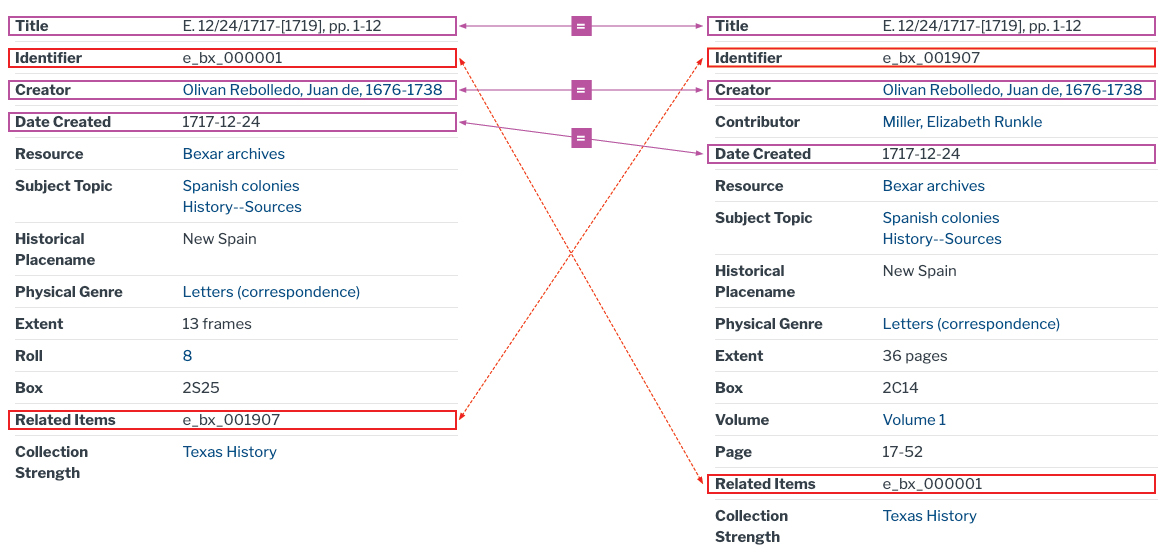
The metadata for both digital files shares the same title, creator, and date created. These shared fields allow us to establish a relationship between the two digital files. The relationship is noted in the “Related Items“ field in the metadata record. As you can see in the image above, it is a reciprocal relationship with the identifier for one being the related item on the other and vice versa.
You can use the title, identifier, creator, date created, and related items fields to search and find both digitized originals/microfilm as well as their corresponding translations. As seen below, searching for the identifier “e_bx_000001” triggers results for e_bx_000001 and e_bx_001907. This is made possible by the related items field in the metadata record for both items. This repository contains translations from the years 1717 to 1792. Translations from 1717 to 1802 are available upon request for use in the Briscoe Center's reading room.
Search results for project identifier "e_bx_000001"
